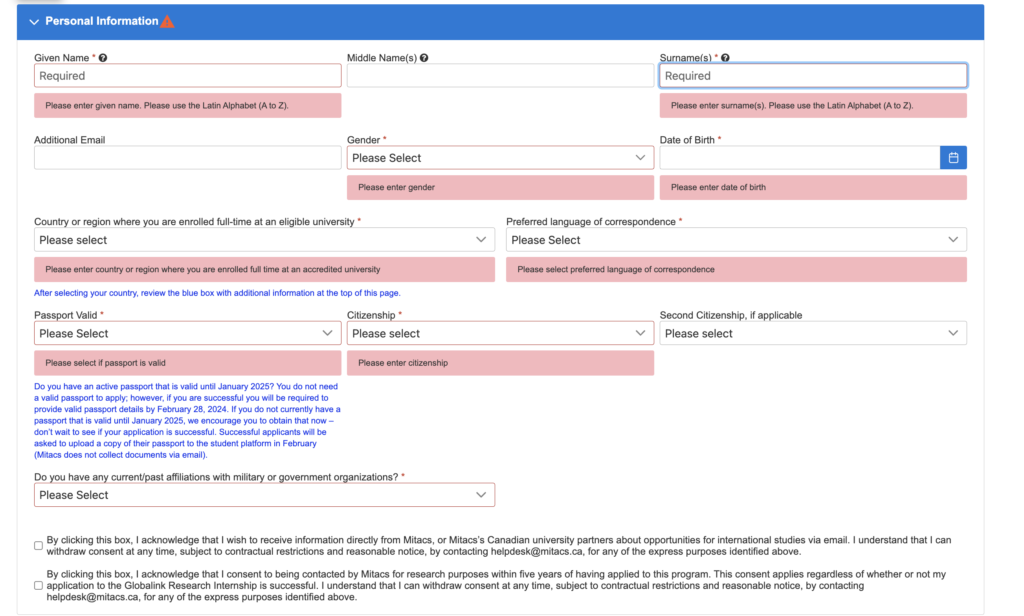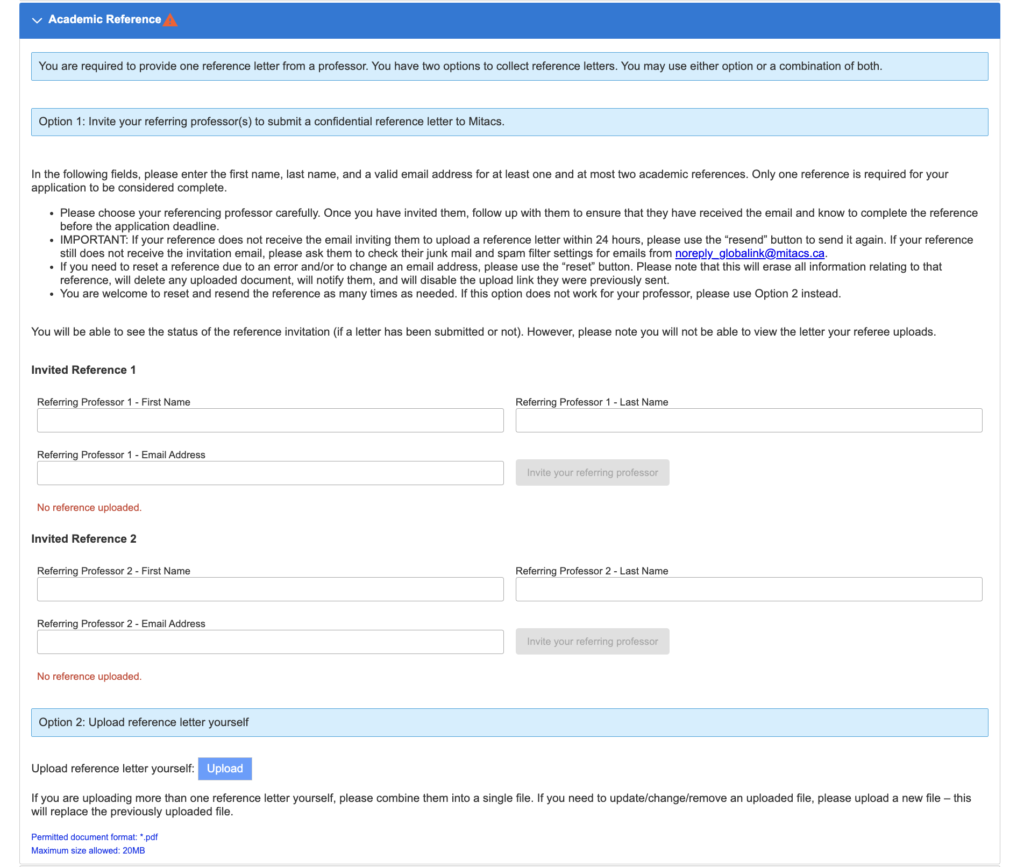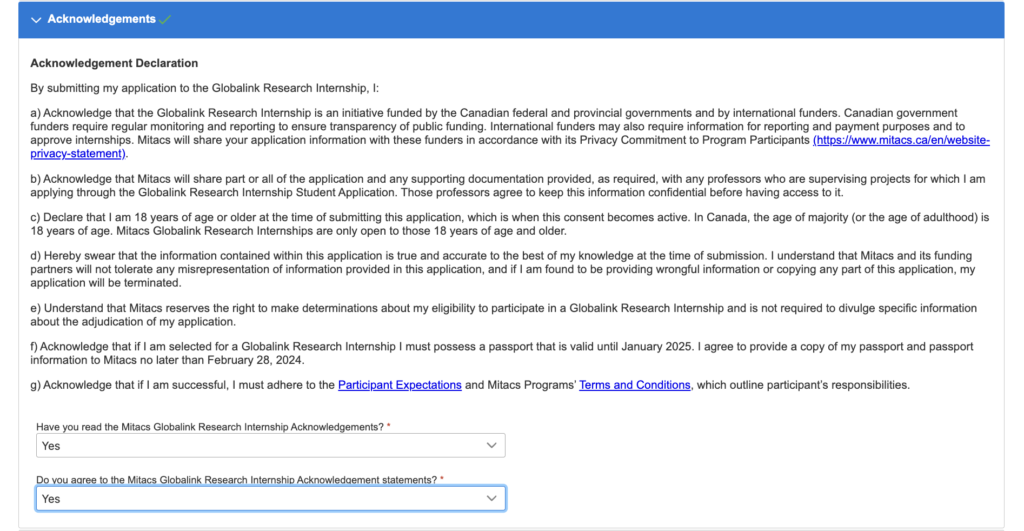Embarking on a research internship abroad can be a life-changing experience, opening doors to new knowledge, diverse cultures, and valuable connections. One exceptional opportunity that paves the way for such transformative journeys is the Mitacs Globalink Research Internship. This coveted program has been instrumental in nurturing the research talents of countless students, connecting them with esteemed institutions and groundbreaking projects worldwide. If you aspire to embark on this exciting academic adventure, you’re in the right place. In this comprehensive guide, we will demystify the Mitacs Globalink Research Internship Application Process, providing you with the insights, tips, and steps you need to successfully navigate this incredible opportunity. From eligibility requirements to crafting a compelling application and preparing for your research adventure, we’ve got you covered. So, let’s dive in!
Table of Contents
Introduction to Mitacs Globalink Research Internship

The Mitacs Globalink Research Internship stands as a highly competitive program, designed for undergraduate students hailing from an array of countries and regions, including Australia, Brazil, Chile, China, Colombia, France, Germany, Hong Kong, India, Mexico, Pakistan, South Korea, Taiwan, Tunisia, Ukraine, the United Kingdom, and the United States. This initiative runs annually from May to October, granting exceptional individuals the opportunity to embark on a 12-week research internship. During this period, they work closely with esteemed Canadian university faculty members, delving into diverse academic fields ranging from sciences, engineering, and mathematics to the humanities and social sciences.
Why Pursue Mitacs Globalink Research Internship?
- Hands-On Research Experience: This program provides a 12-week immersive internship that allows you to deepen your knowledge and engage in hands-on research within your field of study. This practical experience is invaluable in enhancing your academic and professional growth.
- Exceptional Faculty Supervision: During your internship, you’ll have the privilege of working closely with outstanding faculty members, alongside graduate students and research associates. Their expertise and guidance will nurture your research skills and expand your academic horizons.
- Access to Canada’s Research Landscape: Canada boasts a research environment that is both applied and innovative. Through this internship, you gain access to a dynamic research landscape that is at the forefront of various fields, providing a unique opportunity to contribute to cutting-edge projects.
- Holistic Experience: Beyond research, the program offers a comprehensive experience. You’ll benefit from professional skills development courses and engaging social activities that foster personal growth and cross-cultural connections.
- Cultural Immersion: The internship enables you to explore your independence and gain international exposure in a new country. You’ll immerse yourself in Canadian culture, which can be a transformative experience personally and professionally.
- Graduate Studies Pathway: For those considering further education, the Mitacs Globalink Research Internship serves as a bridge to potential graduate studies in Canada. It offers a chance to connect with potential graduate supervisors, making it a stepping stone towards securing Mitacs Globalink Graduate Fellowship for your future academic pursuits.
Application Process
Eligibility
Eligibility criteria for the year 2024 are as follows:
- Age Requirement: Applicants must have reached a minimum age of 18 at the time of application.
- Academic Enrollment: Eligible candidates should be currently enrolled in a full-time undergraduate or combined undergraduate/master’s program at an institution recognized by the program. A list of these eligible institutions, categorized by country, can be found here.
- Remaining Semesters: As of the fall of 2024, applicants should have one to three semesters remaining in their academic program. Specific requirements based on the applicant’s country of study should be consulted for further details.
- Academic Performance: Applicants must meet the grade requirements specified for their respective country of study. These GPA requirements can be found in detail through the country-specific guidelines.
- Project Selection: Each applicant is required to apply to a minimum of three and a maximum of seven projects. Importantly, these selections must encompass projects from at least three different Canadian provinces, ensuring a diverse range of research experiences.
- Language Proficiency: Candidates should possess fluency in the oral and written language associated with their selected project. Proficiency in either English and/or French, as indicated in the project descriptions, is mandatory.
- Availability: Applicants must be available to undertake a 12-week internship, which should fall between May 1 and October 31.
- Previous Award: Individuals who have previously been granted a Globalink Research Internship Award are ineligible to reapply for this opportunity.
Personal Information

The first section of the application is pretty straightforward. Please make sure to accurately fill out your personal information exactly as it appears on your passport.
Education

Moving on to the following section of the application, you will be required to provide information regarding your current educational pursuits. You can find a comprehensive list of eligible institutions categorized by country here. Additionally, please refer to this resource for the minimum average grade requirements, which vary according to your home university’s country. It’s important to note that providing details regarding English or French language proficiency exams is optional.
Background & Research Interests

This section of the application is pretty much like a SOP. This is your chance to stand out to your potential supervisor. Describe your skills, background knowledge, research interests, and experience briefly. The word limit for it is 100 words only. So make sure you write in a crisp and short manner.
★ Pro Tip: Begin by choosing your research projects, then tailor your description to highlight skills, background, and research interests relevant to those projects. This approach ensures you present only pertinent information, eliminating any superfluous details.
Try to add your most recent achievements in the Notable Achievements section. It is followed by a short survey of activities performed during previous internship/project work.

Following the survey, you’ll have an opportunity to showcase your research endeavors. Whether conducted at your home university or any external institution/organization beyond your coursework, sharing this information can significantly enhance your profile and set you apart from your peers.
★ Pro Tip: If you have pursued one or more research internships/projects, mention the work that closely resembles or is directly related to the projects of your choice. This will increase your chances of getting matched with professors with projects in similar domains.
Experience with Mitacs

This section ascertains your availability during the duration of the problem
Academic Reference

In this section, please furnish the details of your academic referees accurately. It’s imperative that you ensure your referees upload their letters well in advance of the application deadlines. You can find specific guidelines for the reference letters here.
★ Pro Tip: It can be particularly advantageous if your research experience with these professors aligns closely with your chosen projects. However, even if your research isn’t directly related, obtaining a letter from a professor with whom you’ve co-authored a published article can be highly beneficial. Such letters allow the professor to speak directly about your research prowess and make meaningful comparisons with other applicants.
Acknowledgments

Read and agree to the acknowledgment declaration.
Documents

The two most crucial documents for this application are your Resume/CV and Transcript. You can access the Mitacs CV template for download by following this link. Typically, a Transcript is a concise, one-page document that provides a comprehensive overview of your course history and corresponding grades during your ongoing university program. In instances where obtaining an official transcript is not possible, you have the option to compile all your grade sheets from previous semesters into a single PDF document. While there is an option to upload multiple transcripts, it is preferable to consolidate them into a single, easy-to-access file for a smoother application process.
★ Pro Tip: While adhering to the template format, consider crafting your own CV. Academic CVs can span up to two pages, allowing you to incorporate relevant research and industry experience, skills, project highlights, and publication details. Additionally, remember to include certificates from online courses (e.g., Coursera, Udemy, etc.), which can serve as tangible proof of your skills. If you have projects hosted on GitHub, create a Readme file that elucidates the project’s essence and include the GitHub links in your CV. It is imperative to keep your CV within the two-page limit, including only details pertinent to the selected projects.
Projects


Undoubtedly, the selection of projects stands as the pivotal element in this application process, as the entirety of your application centers around these projects. You are granted the flexibility to opt for a minimum of three and a maximum of seven projects. A crucial criterion is that your chosen projects must span a minimum of three different provinces, promoting diversity and regional engagement. To facilitate your search, the search and filter option empowers you to pinpoint projects tailored to your specific research area, university, province, academic discipline, language, or preferred supervising faculty.
When it comes to project selection, individuals often adopt varied approaches. I recommend considering three key parameters when finalizing your project choices: the University, the Research Area (Project Domain), and the Supervising Faculty.
Host University

Engaging in research within a prestigious university setting can be highly competitive. Many applicants try to apply exclusively to projects affiliated with a particular university, believing it enhances their chances of selection. While this strategy may yield positive results on occasion, it’s important to note that your application is matched with the professor whose research interests align most closely with your research background. Consequently, I advise maintaining an open-minded approach and selecting projects that genuinely align with your previous research experience or your desired field of interest.
★ Pro Tip: You can categorize your project choices based on QS University Rankings. Consider selecting 2-3 projects from high-ranking universities, 2-3 from mid-ranking institutions, and 1-2 from universities with lower rankings.
P.S.: It’s important to note that when I refer to “high ranking” and “low ranking” universities here, I am making relative comparisons between institutions. Canadian universities, as a whole, provide outstanding research opportunities, and this distinction is not meant to suggest that one university is inherently superior or inferior to another.
Research Area

As I mentioned earlier, your profile will be matched with a professor whose research areas closely align with your background research. Therefore, it’s essential to choose your projects thoughtfully. If you have a research background in a particular area but also have an interest in exploring a different research domain, I encourage you to include such projects in your selection.
★ Pro Tip: If you aspire to delve into research within a specific domain where you lack prior research experience, consider placing such projects in higher priority within your selection. However, it’s advisable to include at least 1-2 projects that closely align with your research background to enhance your chances of selection.
Supervising Faculty

Supervising faculty plays a pivotal role in your internship experience. Collaborating with them and their teams offers a valuable opportunity for personal and professional growth. Therefore, it’s essential to conduct thorough research on the faculty members, understand their research interests. Choose projects from professors whose research closely aligns with your own interests to maximize your learning and engagement during your internship.
Behind the Scenes: The Selection Process

Stage 1: Application Screening

Mitacs carefully reviews all GRI applications. If your application meets the eligibility criteria, your status will be updated to either “Candidate under Consideration” or “Waitlisted.”
If your application status is “Candidate under Consideration,” it will be shared with the professors for further consideration. During this phase, you have the opportunity to re-evaluate and adjust the priority order of your chosen projects if desired.
★ Pro Tip: If you believe you made an error in your project priority order, this is your chance to correct it. Keep in mind that you can only modify the priority order of the projects; you cannot add new projects at this stage.
Stage 2: Matching with the Professors

After your application is shared with the professors, you may receive contact from them for interviews, typically via email or online video platforms such as Skype, Zoom, or Microsoft Teams. The scheduling and format of these interviews are determined at each professor’s discretion. If your application stands out, you might even receive interview invitations from multiple professors.
★ Pro Tip: Be well-prepared for these interviews. Professors have varying approaches; some may select students based solely on the application, while others may test theoretical knowledge or even conduct live coding assessments during the interviews! Therefore, it’s crucial to be ready, as the interview nature and possibilities can vary significantly from one professor and project to another.
Stage 3: Internship Offer

If the professor is satisfied with your application and interview performance, they will extend an internship offer to you. You’ll have a designated period to accept the offer, and after that, it will no longer be valid. Once you’ve accepted the offer, Congratulations, you’re all set for an exciting adventure!
For candidates whose application status was initially “waitlisted,” there’s hope for it to change to “candidate under consideration” in subsequent rounds. The number of such rounds can vary from year to year. To my knowledge, in 2022, there were just two rounds, but in 2023, there were 3-4 such rounds. So, don’t lose hope. Receiving an offer early is undoubtedly exciting, but securing one in later rounds can be equally advantageous.
★ Pro Tip: Even if your application status is “candidate under consideration,” it doesn’t guarantee a match with a professor. This could occur if your background doesn’t closely align with the chosen projects. That’s why it’s advisable to keep at least 1-2 projects that directly match your background experience.
As you embark on this exciting journey of opportunities and possibilities, remember that the Mitacs Globalink Research Internship can be a transformative experience. It’s a chance to learn, grow, and make meaningful contributions to your field of study. Embrace each step of the application process with enthusiasm and resilience, knowing that every effort you put in brings you one step closer to your goals. Whether you receive an offer early on or in a later round, your dedication and passion for research are what truly matter. So, seize this chance to expand your horizons, build lasting connections, and excel in your academic pursuits. Here’s to your future success!
About the Author
I’m Ritik Bompilwar, MITACS Globalink Research Intern’22, and Globalink Research Ambassador’23. Thank you so much for reading my blog. I’m grateful for the opportunity to share insights and experiences with you.
Feel free to connect with me through the provided links, and I look forward to sharing more inspiring content with you in the future.
Thank you for being a part of my journey.
Warm regards,
Ritik Bompilwar



Great topic, please keep it up I really enjoy reading these type articles.
Thank you so much for your encouragement.